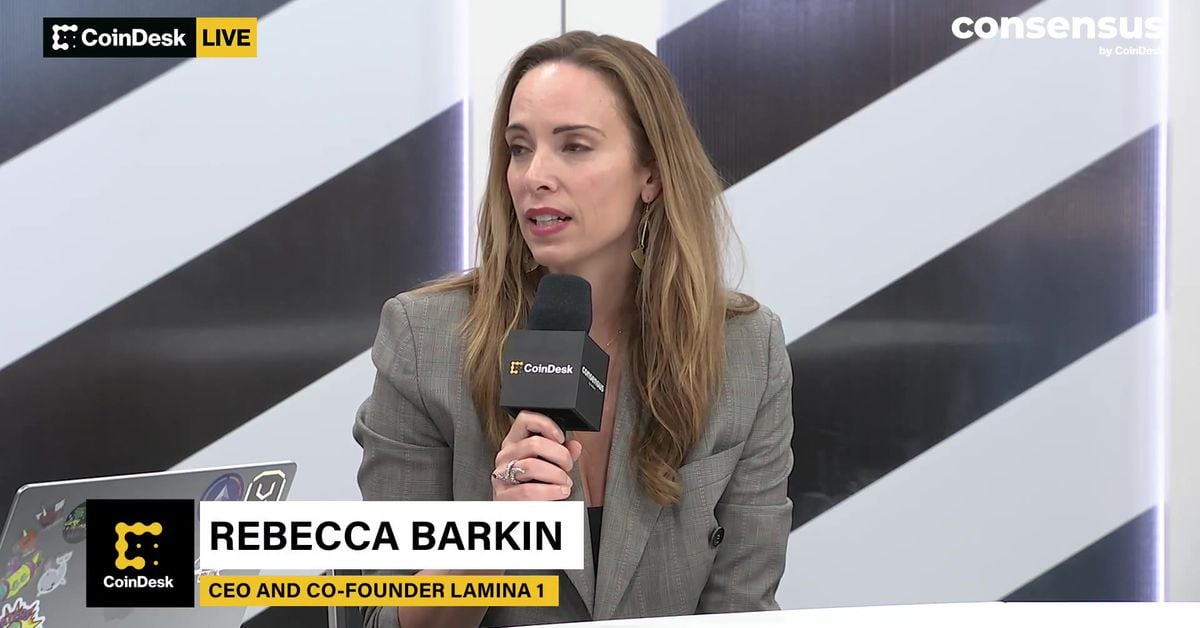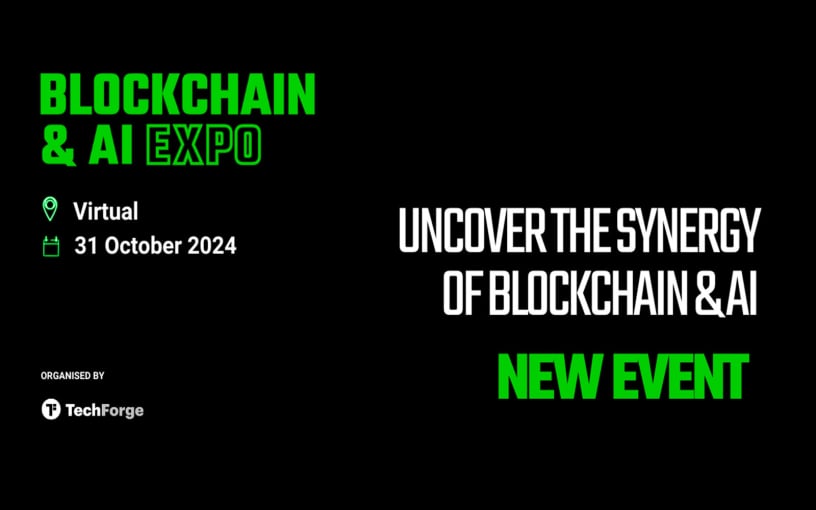News
Live from consensus 2024 | Enabling Fluid Identity and Asset Movement with Blockchain | video

Well, welcome back to the show. We’re joining you live from the Coin Desk podcast studio presented by Bit Go. Actually, it’s our TV studio, not a podcast studio um founded in 2013 with the first institutional-grade Bitcoin wallet Bit Go is the gold standard in custodial staking liquidating today. Bit Go supports over 800 bit coins and processes 20% of all Bitcoin transactions by value. Check them out on Bit go.com. Um We’ve talked to so many influential people over the last three days. We’re very excited to have our next guest. Um our next guest, Lamina, a co-founder, Ceo Rebecca Barkin, Rebecca. It’s great to see you and Rebecca and I have just met on Zoom. So it’s the first time, you know, when you see someone and you’re like, he’s taller, he’s shorter, he just looks different. I feel like this is that moment. There’s a, there’s a story there. Yeah, I mean, because you’ve been involved in immersive work for a long time as well. I know I’ve only seen you in the metaverse. Yeah, that’s right. That’s right. Yeah, it’s nice to be here. Thank you. For having me. Sure, Rebecca for, I’d love to before we even get started, I think you have such a fascinating story. Um So I know you’re here at consensus. We’re going to talk about Lamina, but I’d love for you to tell us the 30 seconds of how you got to this moment. Yeah. Yeah. Sure. Um Thanks for asking. Yeah. So I started my career in entertainment actually in music, right? When they were going through this really difficult transition of trying to figure out what the value of intellectual property is in the digital age. And then I went to film just in time for them to be going through the exact same thing. Um, it became really clear to me where we were going with entertainment, if you really valued intellectual property you had to figure out because technology was kind of in the driver’s seat at that point. And so I went, um moved to Silicon Valley and took actually now that I think about it, it was a music, integrated music and uh hardware and software. And then positional tracking, I kept going down the hole, positional tracking. And then I magically went um where I led studios there for four years and developing uh a series of AR applications um which was really a big learning curve on where everything was going spatial processing and uh large-scale location-based immersion. Um And what were the things that were holding us back when we moved up the enterprise? I led the operating system redesign for Magic Leap Two. And then I went to MS G sphere uh where we were working. Um, you know, what kind of content and technical partnerships were needed to bring immersion to that scale to really use that technology in a way that emotionally resonated with people. Um, I was there when, um, you know, Neil and I worked together on Magic League for years. So, um, I was there, yeah, like we worked together, to adapt some of its IP to world-scale augmented reality, you know, gaming. Yeah. And so he called me when I was at Sphere and he said, hey, you know, I’m on tour for Termination Shock right now and, um, that was his book at the time. And he’s like, you know, people keep asking me about the metaverse and what I think about Mark Zuckerberg’s version of the metaverse. And he said, you know, I guess I could just keep traveling around the world talking about it and this, you know, what’s wrong with it or what I’m doing differently or I could build the tracks myself. And so he asked me to go do that with him and uh Peter Vane, the third co-founder. Yeah. So Lamina one, so co-founded by Neil Stevenson and famous author of Snow Crash, as well as a lot of other books. I was fortunate enough to interview Neil, uh two years ago here at consensus. And I think that was when they first announced Lamina one. Very exciting. But one of the things that stuck in my mind when he announced it was that he really wanted to create something that wasn’t like some of the others. Um L one and L two that were coming out that were very financialized and really just focused on, you know, just token sales, maybe you could fill us in. Like, is that still the vision today? Yeah, I mean, even more so. So I think, you know, so what we wanted to do was improve the creator economy. Um, we felt like the current system of funding creative content, distributing it, monetizing it, and directly connecting IP owners with their fans was just broken and that, that kind of IP licensing system and the studio system was a little bit outdated. Um, so we felt like Blockchain was a fundamental foundation even if magically if we talked about how Blockchain was a fundamental foundation for opening up a metaverse because really your identity needs to be able to travel seamlessly with you and your assets across this world of interconnected physical and digital experiences and really only Blockchain could do that. Um, so as AI gets more and more mainstream, there’s kind of, how do you verify and how do you make sure that this is someone’s identity and that you’re protecting someone’s IP. So, you know, Neil has a long, long history of being an IP owner. So who better than someone who understands and protects the aesthetic quality and the storytelling, uh, in how technology is developed and we had the same philosophy of the magic leap? So we just kind of took it forward. But what we realized very quickly was that you can’t just create a protocol, you can’t just, you can’t just create a layer one. And we thought that a lot of what needed to be unlocked was actually at the application layer versus the consensus layer. And so we really focused our time and energy on how do we create not just a protocol, but the platform stack on top, there was no code that would connect IP owners directly with their fans. And we, we built the um, we always thought that Avalanche had a really cool architecture to enable that because it can keep developer costs low and predictable. Um, protect performance and enable this kind of interoperability ecosystem all the way through. And so we adopted that as our consensus layer and really put all of our energy and effort into building the application layer stack and Rebecca, this has been a big week, right? You guys went live with your mainnet. So yeah, tell us about, you know, just the launch what that was like and then also how everyone from IP holders to developers can build on the platform. Yeah, yeah. So um it’s been a really exciting week for us, for sure. Um Called two years as through the toughest market, I mean, metaverse and cryptocurrency were toxic terms for the last couple of years. But we’ve really stuck to our guns. Um We’ve shifted our focus a little bit just to say you don’t want to just focus on VR or A R. So how do we build a platform that’s welcoming to a much broader and broader set and we really decided to focus on trans media? So how do we take an IP holder that has this kind of broad set of trans media content and connect it directly to fans and make it easy for them as fans to create together? That was number one. And then the design of Tonos. So we just wanted to make sure that we enabled a new kind of economic design that encouraged creative reinvestment. So this week or actually on May 17th, we had our TGE which was like a, a huge event for us. A huge milestone. I mean, we’re a small but very, very powerful team of nine. So we’ve been doing that for the last two years. And uh we had our main night live on 517 and then just uh on the 28th at the two-year consensus today, uh we uh announced public access to the beta platform. So developers can go to Lama one.com and that domain is like coming into our hub, where you have a wallet, it’s like a very web two login process, super simple and streamlined and then you go in there and it’s very experience first so you can explore other content creators. Uh And then our creation studio allows people to actually upload and publish content uh to create web based mini games where you can have a co-creation within permission uh some sort of IP uh to build together. Uh And so, you know, we have a unity SDK, we have an Unreal STK, we’re just trying to embrace all the great technology that’s already out there, but weave it together to bring it together in a way that’s really uh simple for people to use and onboard. So it’s up and running, people should go check it out. Uh We’re in our early days. Uh So that’s what we, let’s say it’s beta uh on the public platform side, but the mainnet is live. So you keep talking about interconnectivity and interoperability like it sounds like a super important topic. How do you think metaverse platforms like yours and others will coexist in the future? That’s a really, really important question and I, I don’t think we, we’ve necessarily talked about it enough in the, in the right way in terms of what the obstacles are. So interoperability can start with identity and assets to travel. But the reality is we could talk about mash up games all day, we can talk about like, can I bring my sword and football game or whatever? But that basically requires creators to build in a completely different way. That’s a huge advantage when you’re building a two-sided platform or marketplace. So, you know, we decided to take a little bit of a different approach and we’ve been working with a lot of our partners who are really focused on standards, right? So part of the challenge, even magically, was like, how do you, there was no easy way to move content because the metadata on the assets, like if you were moving from one platform to another with different processing, you know, capabilities and whatnot, it didn’t maintain the aesthetic quality. You’re talking about shaders, you’re and these are things that artists really care about. So actually our friends at Future Verse um are developing a standard called UBF uh that can be used to dynamically detect what platform you’re on and then enable transcoding for those assets where you take the metadata and all those kinds of credits, the royalties, all that kind of stuff that you’d have to carry with you and allow it to travel uh from one environment to another while protecting the aesthetic quality. So I think when we took a step back and looked at where the interoperability actually is, it’s like we have all the technical infrastructure to enable it, but we don’t have, the content isn’t there. The creators that are making that content at a level of quality that people care about aren’t there yet. So what are the foundations? It’s identity and assets. We just allow uh through avalanche and Lama to their own content ecosystem, those things to communicate with each other really seamlessly and work with partners to actually implement the standards. Let’s pick one rather than go sit on boards all the time and talk about it, you know, so we think that’s a great step forward and we’re always looking for that, but this, this is a really, really important part of encouraging uh true interoperability. Yeah, Rebecca. Thank you so much for being with us today. Um, you guys have been a great partner for us here at consensus.
News
Blockchain Technology Will Transform Water Access and Management Globally

Disclosure: The views and opinions expressed here are solely those of the author and do not represent the views and opinions of the crypto.news editorial team.
Access to clean water is a basic human need, yet billions of people around the world still struggle to get it. According to the World Health Organization, over 2 billion people live in countries suffering from severe water stress, and this number is expected to continue to grow due to climate change and population growth.
Traditional water management systems have struggled to address these challenges, often hampered by inefficiencies, lack of transparency, and misallocation of resources. Blockchain technology offers a promising solution to these challenges, providing equitable access and sustainable use of this crucial resource.
The current state of water management
Water management today faces several pressing issues. Inefficiencies in water supply, distribution, and use, coupled with a lack of real-time monitoring, often result in resource waste and misallocation. Many water sources fail to realize their full potential due to infrastructure and financing shortfalls. For example, the Environmental Protection Agency (EPA) report indicated that the United States would need to invest $625 billion over the next 20 years to repair, maintain and improve the country’s drinking water infrastructure due to aging pipes and other infrastructure problems. Additionally, in the United States alone, household leaks can to waste nearly 900 billion gallons of water per year nationwide. This is equivalent to the annual domestic water consumption of nearly 11 million homes.
Furthermore, corruption and mismanagement of water resources can cause unequal distribution, with disadvantaged communities often bearing the brunt of water scarcity. For example, South Africa is struggling with myriad challenges to its water security: drought, inadequate water conservation measures, outdated infrastructure, and unequal access to water resources. The country faces significant water scarcity, with demand expected to outstrip supply by 2030, creating a projected gap of 17%.
Furthermore, the global water industry is highly monopolized, with a few key players controlling a significant share of the market. These companies exert substantial influence over the water supply chain, often prioritizing profit over equitable distribution and environmental responsibility. This concentration of power can lead to inflated prices and limited access for vulnerable populations. The global bottled water market alone is projected to reach $509.18 billion by 2030, with these large companies capturing a significant share of revenue. This monopolization exacerbates existing inequalities in water access and highlights the need for more decentralized and community-driven water management solutions.
Source: Grand View Search
The potential of blockchain in water management
Blockchain technology can address these issues by providing a transparent, secure, and decentralized platform for water resource management. This approach offers several advantages:
- Transparency and accountability. Blockchain’s immutable ledger ensures that all transactions and data entries are transparent and cannot be changed once recorded. This transparency can reduce corruption and ensure that water resources are allocated fairly and efficiently. For example, blockchain can be used to track water usage from source to end user, providing a clear record of how water is distributed and used. This level of transparency can help hold authorities accountable and manage water resources sustainably.
- Efficient resource management. Blockchain can facilitate the creation of smart contracts, which are self-executing contracts with the terms of the agreement written directly into the code. These contracts can automate water distribution based on real-time data, directing water to where it is needed most. For example, smart contracts could be used to manage urban water supply systems, automatically adjusting water distribution based on real-time consumption patterns and demand. This can help optimize water use, reduce waste, and ensure that households and businesses receive the right amount of water at the right time.
In Dubai, the Dubai Electricity and Water Authority (DEWA) has implemented a blockchain-based smart water network initiative as part of its broader smart city strategy. This project integrates blockchain technology with IoT sensors to monitor water usage in real time, manage distribution, and detect leaks. The decentralized ledger ensures data integrity and transparency, enabling more efficient water management and reduced waste. DEWA’s initiative aims to improve sustainability and resource management in the rapidly growing city, highlighting the potential of blockchain to support urban water management and conservation efforts.
Community participation and ownership
Through blockchain, individuals can directly control and monetize their access to water resources, eliminating the need for third-party intermediaries. This direct control model allows local communities to make collective and transparent decisions about their water use. By managing their water directly from the source, communities can tailor water management practices to their specific needs, promoting equitable distribution and encouraging a sense of accountability and stewardship.
Additionally, future models could allow people to monetize their access to water through web3 technologies. For example, a community-to-business (C2B) model could allow people to sell water directly to companies. In this model, people do not have to own the water directly, but can profit by staking their tokens during event sales pools. This approach not only supports sustainable water management, but also creates economic opportunities for community members. Additionally, a “Burn to Secure” protocol can be used to provide water allocation rights. This protocol provides a true sense of water security and financial opportunity by allowing people to redeem their rights. This system not only secures future water allocations, but also increases token scarcity and value.
Additionally, a pure sense of investment is achieved through investments in water sources. This leads to potential financial returns and dividends by addressing the inefficiencies in water supply mentioned above. By investing to finance infrastructure projects, such as building factories and improving distribution systems, more water can be brought to communities, creating additional economic opportunities.
Monetizing water access through the C2B model, the “Burn to Secure” protocol, and investments in water sources all generate economic benefits for the community, promoting a more equitable and efficient water management system.
Overcoming challenges
While blockchain technology has the potential to improve water management, there are challenges to its adoption. The complexity of blockchain systems and the need for technological infrastructure can be barriers, especially in developing regions. Additionally, there are concerns about the significant energy consumption of blockchain networks. However, technological advances and the development of more energy-efficient blockchain solutions are helping to alleviate these concerns. Additionally, education and capacity building are key to ensuring stakeholders understand how to effectively use blockchain technology. Governments, NGOs, and private sector partners need to work together to provide training and support to communities and water management authorities.
Blockchain technology offers a practical and effective means to improve water management. In addition to addressing inefficiencies, blockchain empowers communities, promotes sustainable practices, and opens up new economic opportunities through models like community-to-business (C2B). As we face the growing challenges of climate change and population growth, blockchain is not only an innovative solution, but represents a fundamental shift in the way we manage and value water resources. Adopting blockchain in water management is essential to creating a sustainable and equitable future by changing the way we interact with and protect our most vital resource.

Jean-Hugues Gavarini
Jean-Hugues Gavarini is the CEO and co-founder of LAKE (LAK3), a real-world asset company leveraging blockchain technology to decentralize access to the global water economy. LAKE aims to ensure access to clean water for all, protect water resources, and deliver water to those in need through innovative technologies. Jean-Hugues has a diverse career spanning the luxury, fashion, and footwear industries. His career path includes notable successes at Mellow Yellow, Cremieux, and Tod’s. Raised between Silicon Valley and the French Alps, Jean-Hugues has always been immersed in technology and freshwater resources. In 2018, Jean became the CEO of Lanikea Waters, a water solutions entity based in the French Alps. In 2019, the concept of LAKE was born, embodying his commitment to innovation and sustainability.
News
Blockchain and AI Expo 2024

With rapid advances in the world of AI and blockchain, there are opportunities to leverage the security and transparency features of blockchain to improve the reliability and trust of AI systems and data transactions.
Explore the synergy of these advanced technologies in virtual mode Blockchain and AI Expowhich takes place on October 31, 2024 TO 10:00 GMT.
The event features cutting-edge presentations led by leading experts in evolving fields. Presentations are set to explore opportunities and challenges in the fusion of blockchain and AI, real-world applications, ethics, innovations in environmental sustainability, and more!
Gain a comprehensive understanding of how these technologies can synergistically drive innovation, optimize operations, and promote strategic growth opportunities. Develop your knowledge to facilitate informed decision making and give your company a competitive edge in the growing technology landscape.
News
Nigeria Eyes National Blockchain Nigerium for Data Sovereignty

Nigeria is keeping an eye on a new native blockchain network to protect the country’s data sovereignty.
According to local media, a team from the University of Hertfordshire has proposed the new blockchain, Nigeriato the National Information Technology Development Agency (NITDA).
Chanu Kuppuswamy, who leads the team, argued that relying on blockchain networks whose developers are located in other regions poses national security risks to the Nigerian government. He further said that Nigerium would allow the West African nation to customize the network to meet specific needs, while also promoting data sovereignty.
In his presentation, Chanu cited the recent migration of Ethereum to test of participation (PoS) consensus as an instance in which no Nigerians were involved but whose impact is far-reaching.
“Developing an indigenous blockchain like Nigerium is a significant step towards achieving data sovereignty and promoting trust in digital transactions in Nigeria,” he said.
While receiving the proposals in Abuja, NITDA’s Kashifu Abdullahi acknowledged the benefits a local blockchain would bring to Nigeria, including increased security of citizens’ data.
However, a NITDA spokesperson later clarified that Nigerium is still at the proposal stage and that the government has not yet decided whether to proceed or not.
“The committee is still discussing the possibility with stakeholders. Even if a decision is finally made, there is no guarantee that the name will be Nigerium,” the spokesperson told the media.
Nigerium’s reception in the country has been mixed. Some, like financial analyst Olumide Adesina, To say the network is “dead on arrival”. He believes the Nigerian government’s poor record in following through on its big technology plans will claim another victim. He pointed to the eNaira as a missed opportunity whose chances of success were much higher than those of Nigerium.
Others welcomed the proposal. Chimezie Chuta, who chairs the renewed The Nigerian Blockchain Policy Committee is “extremely optimistic“that Nigerium will be more successful than eNaira.
Speaking to a local news agency, Chuta stressed that eNaira failed because the central bank initiated the project on its own, without involving any stakeholders.
“They just cooked it and expected everyone to like it. [With Nigerium]there will be a lot of collaboration,” he said.
Registration of property title, digital identity and Certificate Verification are among the use cases that Nigerium is expected to initially target. However, Nigeria has already made progress in some of these fields through public blockchains.
SPPG, a leading school in governance and politics, announced in May the country’s first blockchain certificate verification system. Built on the The BSV BlockchainIt was developed in collaboration with the blockchain data recording company VX Technologies and local lender Sterling Bank.
Watch: The Future Has Already Arrived in Nigeria
 Italian: https://www.youtube.com/watch?v=M40GXUUauLU width=”560″ height=”315″ frameborder=”0″ allowfullscreen=”allowfullscreen”>
Italian: https://www.youtube.com/watch?v=M40GXUUauLU width=”560″ height=”315″ frameborder=”0″ allowfullscreen=”allowfullscreen”>
New to blockchain? Check out CoinGeek Blockchain for Beginners section, the definitive guide to learn more about blockchain technology.
News
Cambodian CBDC Developer to Build Palau Bond Market on Blockchain: Report

A Japanese fintech developer will build a blockchain-based bond market gateway for Palau, aiming to launch a trial in 2024 and a full launch the following year.
Japanese fintech developer Suramitsubest known for developing a central bank digital currency (CBDC) for Cambodia, is intended to build a Blockchain-gateway to the bond market based on the Pacific island nation of Palau, Nikkei He learned.
Soramitsu won the contract and plans to introduce the market on a trial basis in fiscal 2024, with a full launch scheduled for the following year, allowing the Palauan government to issue bonds to individual investors and efficiently manage principal and interest payments, according to the report.
The total cost of the project is estimated at several hundred million yen ($1.2 million to $5.6 million), less than half the cost of a non-blockchain alternative, people familiar with the matter said. The project has reportedly received support from Japan’s Ministry of Economy, Trade and Industry, with Japan’s foreign and finance ministries providing strategic and management advice on the project.
Soramitsu’s successful development of Cambodia’s CBDC in 2020 has boosted its reputation, with the digital currency’s popularity soaring, with over 10 million accounts opened by December 2023, representing 60% of Cambodia’s population. Following this, Cambodia’s central bank governor Chea Serey indicated intends to expand the reach of its CBDC internationally, particularly through collaboration with UnionPay International, the Chinese card payment service, and other global partners.
While Soramitsu’s work in Cambodia has been well received, the long-term popularity of CBDCs remains to be seen. As of late June, crypto.news reported a sharp drop in activity in India’s digital currency, the e-rupee, after local banks stopped artificially inflating its values.
According to people familiar with the matter, the Reserve Bank of India managed to hit the 1 million retail transaction milestone last December only after the metrics were artificially infiltrated by local banks, which offered incentives to retail users and paid a portion of the bank’s employees’ salaries using the digital currency.
-

 News1 year ago
News1 year ago“Captain Tsubasa – RIVALS” launches on Oasys Blockchain
-

 Ethereum1 year ago
Ethereum1 year agoComment deux frères auraient dérobé 25 millions de dollars lors d’un braquage d’Ethereum de 12 secondes • The Register
-

 News1 year ago
News1 year agoSolana ranks the fastest blockchain in the world, surpassing Ethereum, Polygon ⋆ ZyCrypto
-

 Videos1 year ago
Videos1 year agoIs Emorya the next gem💎 of this Bitcoin bull run?
-

 Videos1 year ago
Videos1 year agoHistoric steps for US cryptocurrencies! With a shocking majority vote!🚨
-

 News1 year ago
News1 year agoSolana Surpasses Ethereum and Polygon as the Fastest Blockchain ⋆ ZyCrypto
-

 Videos1 year ago
Videos1 year agoNexus Chain – Ethereum L2 with the GREATEST Potential?
-

 Ethereum1 year ago
Ethereum1 year agoScaling Ethereum with L2s damaged its Tokenomics. Is it possible to repair it?
-

 News1 year ago
News1 year agoFnality, HQLAᵡ aims to launch blockchain intraday repositories this year – Ledger Insights
-

 Regulation1 year ago
Regulation1 year agoFinancial Intelligence Unit imposes ₹18.82 crore fine on cryptocurrency exchange Binance for violating anti-money laundering norms
-

 Bitcoin1 year ago
Bitcoin1 year agoBitcoin Drops to $60K, Threatening to Derail Prices of Ether, Solana, XRP, Dogecoin, and Shiba Inu ⋆ ZyCrypto
-

 News1 year ago
News1 year agoSendBlocks Debuts with Major Support to Improve Blockchain Data Management










